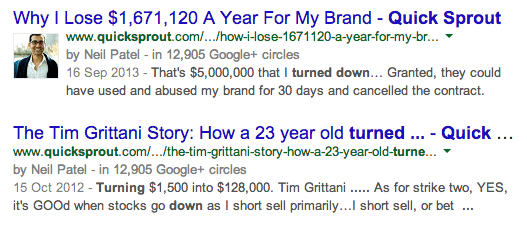Over the years, the function of the headline has evolved. In the days of print, it served the purpose of catching the eye. Then along came Google. With the shift towards search-based discovery, the headline also had to take keywords into consideration.
“Five times as many people read the headline as read the body copy. When you have written your headline, you have spent eighty cents out of your dollar.” — David Ogilvy
Today we’re experiencing another shift led by social behaviour. Headlines now need to be all of the above, as well as being shareable and extremely clickable.

So what constitutes a good headline these days? I’ve listed some of the key components below, but I want to first clarify that none of the fundamentals of headline writing have changed. As human beings, we haven’t really changed. It’s the technology that’s changed – and the headline formats are simply adapting to these new technologies.
So, how can you write better headlines today?
1. Write more headlines
Want to know Upworthy’s secret to reaching 80,000,000 unique visits per month? They write more headline variations than anyone else. Every post published to Upworthy has 25 different headlines that are A/B tested to find the one that’s most clickable and shareable. Upworthy doesn’t care about poor grammar, headline length, or any headline writing conventions for that matter. They simply write a large number of variations and let science pick the winner.
2. A/B test your headlines
The best way to learn what makes a good headline is to have the opportunity to split test them. I use a dead simple WordPress plugin called Title Split Testing to create a bunch of headline variations for every post I write. The value of doing this is not necessarily the fact that you end up with a 1.5% increase in click through rate, but more that you learn very quickly what headline formats work well, and how important it is to test assumptions.

3. Use numbers, and make them big
One thing that virtually every guide on headline writing agrees on is that numbers work, and big obscure numbers work the best. All else being equal, ‘109 Ways to Grow Your Blog’ will outperform ‘6 Ways to Grow Your Blog’. Why? Because it promises more value, and hopefully delivers on that promise.
4. Use digits instead of words
One thing that I’ve A/B tested a few times is comparing ’10 Ways to’ vs. ‘Ten Ways to’. In virtually every scenario the digits outperform the words.
5. Place the number at the start of the headline
If you’re writing a list, it’s usually better to structure the headline with the number at the start. For example, ’10 Ways to Grow Your Blog’ is probably better than ‘How to Grow Your Blog in 10 Steps’
6. Make an overly ambitious promise and over deliver on it
The best headlines make a promise to do something valuable or emotionally stimulating. ‘How to generate $1,850,000 per year from blogging’ is an incredibly compelling headline that makes a huge promise. If you could write an article that genuinely showed replicable formats and case studies on how that’s attainable, you’ve delivered on your promise.
While I’m not a fan of their headlines, Upworthy and Buzzfeed make huge promises in their headlines that their content will make you experience extreme emotional responses e.g. “You’ll cry when you see this tiger shaking hands with this baseball bat” (probably not an actual Buzzfeed headline, yet).
7. Teach people something useful
We enjoy learning new skills that complement our goals and our lives. For this reason, headlines containing ‘A Beginners Guide to’, ‘DIY’, ‘Introduction’, ‘In 5 Minutes’ tend to work very well.
8. We prefer secrets, ideas, reasons, and facts
I’m guilty of this one – I’m always writing about ‘X tips’. Tip is a pretty shoddy word – giving someone a tip isn’t usually that life changing, it’s usually just a little nudge. We’d much prefer a secret, an idea, or a reason to do something new.
9. Create a sense of urgency
Adding urgency in a headline usually just requires appending the word ‘now’ or ‘today’ at the end of it. ‘7 Ways to Grow Your Blog Right Now’ is far more compelling than ‘7 Ways to Grow Your Blog’. Alternatively, you could increase urgency by implying the effects of ignorance, for example, ’10 Mistakes You Don’t Want to Make While Running a Blog’.
10. Standing out from the crowd
The danger of writing an article like this is that everyone ends up conforming to a set of principles. As in all forms of creative marketing, when everyone starts doing things one way, those ways tend to lose impact and a new way becomes more effective. That’s why we need to consider zigging when others zag.
I’ll give you an example, a few years ago I split-tested two email campaign subject lines. In one of them, I started the subject line with ‘>> [important]’.
Adding this unusual set of symbols and the word important increased the open rate by about 30%. Why? It stood out from everything in the recipient’s inboxes and increased the urgency of the email.
Pro-tip: if you ever want someone to respond to an email, just add ‘[urgent]’ or ‘[important]’ at the start ;-)
11. Be extremely specific
The saturation of content marketing has meant that we’re seeing a lot of very similar headlines popping up. I wonder how many guides to blogging or top tips for social media management have been written?

The way to cut through this is to be extremely specific. One of the reasons why I admire Neil Patel’s posts on Quicksprout is because he’s very specific with his headlines. Neil writes headlines like ‘Why I turn down $1,671,120 a year to protect my brand’ and ‘How X increased my traffic by Y% in Z days’. Being ultra-specific is one of the secrets to Neil’s blogging success.
12. Make your headlines work out of context
Regardless of how short your headlines are, they should work out of context. Seth Godin may be the one exception who gets away without this, but generally a reader needs to understand what they’re going to get from reading your article by scanning the headline in a Twitter feed.
13. Opt for as fewer words as possible
I’m a fan of simplicity and admire the BBC’s ability to write very punchy short headlines that do most of the above often in six or fewer words. Remember that Google displays a 70 character limit in search results for titles, and Twitter has a 140 character limit. Don’t let these limits govern your headline, but do be mindful that if your headline is over 70 character, it’s probably convoluted to some degree.

14. What’s in it for me?
Ask yourself, if you saw this headline would you click on it? If not, what would make you click on it? If your headline doesn’t convey what’s in it for the reader, consider what you’re really offering the reader and try to be more specific, or more emotional with your headline.
15. Write something that people will want in their newsfeed
One of the unique challenges that we must consider today is whether our readers would want our headline popping up in their friend’s newsfeed. In Jonah Berger’s great book ‘Contagious’, he found that people share things to produce and accumulate social currency. In other words, we share things that make us look rich, cool, clever, or other personal traits that we generally want others to see in us.
What would your headline say about a person who shared it?
16. Use interesting adjectives
‘6 essential tips’ is somehow better than ‘6 tips’, in the same way that surprising facts are generally better than just facts. Use interesting adjectives to add emotions into your headline writing.
17. Pique people’s curiosity
Remember how cliff-hangers made you feel when you got to the end of a story? Wanting more. That’s the effect we need to replicate with our headlines – giving just enough information to create interest, but with enough mystery to pique people’s curiosity and encourage them to click.
18. Ask a question?
A few years ago I read about how our brains are unsatisfied when they see a question mark but don’t know the answer. The instinctive reaction to seeing a question mark is to find the answer. In the online World, this often results in the reader clicking.
19. After all else, remember keywords
SEO is still incredibly important. Despite the increasing prominence of social sharing, Google is still the primary traffic source to the majority of websites. My advice is to consider the keywords you’re using in your headlines after you’ve done all of the above.
Image Credit: Christopher Woo




